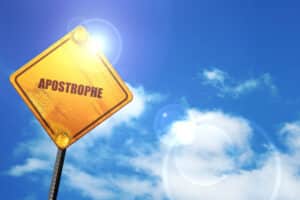In content marketing your main focus will arguably be creating copy that effectively reaches your target audience. As such, the actual content of the copy is the most important part of the creation — in other words, the words you use and how you weave them together to create meaning. But another critical piece of this puzzle is the punctuation you use when you draft your content. Misplaced or incorrect punctuation gives your audience a poor impression of you as a brand, may lead to unfortunate misunderstandings and in some cases can even cost you money. In this blog post we discuss some of the most common punctuation mistakes in content marketing and how to effectively fix them.
The Top Ten Punctuation Mistakes In Content Marketing
- Mixing up commas and semicolons
Perhaps one of the biggest punctuation mistakes I see in content marketing is the misuse of semicolons and commas. More specifically, semicolons used in the place of commas and vice versa. Though it can be confusing at times, below is a summary of how each should and shouldn’t be used.
The mistake: The traffic was crazy today; but I arrived on time.
The correction: The traffic was crazy today, but I arrived on time.
The explanation: In general, a semicolon should be used to link independent clauses that are not joined by a coordinating conjunction. They indicate a greater separation of thought than a comma can convey, but less of a separation than a period provides. Since the above sentence is joined by a coordinating conjunction, a comma is needed instead of a semicolon.
If this still feels confusing to you, use this trick to help you remember: If both sides of your sentence can stand alone on their own, use a semicolon instead of a comma.
- Incorrectly punctuating acronyms
An acronym is a word formed from the first letter or letters of a series of words. This is usually done for convenience when a title or name is especially long and cumbersome. In content marketing, the use of acronyms is particularly useful when up against character limits on various platforms. The following examples are some of the most frequently occurring punctuation mistakes involving acronyms.
The mistake: Ninety-five percent of the C.E.O.’s surveyed agreed that employees should be given the option to work from home or from the office.
The correction: Ninety-five percent of the CEOs surveyed agreed that employees should be given the option to work from home or from the office.
The explanation: Two of the punctuation mistakes I often see in content marketing have to do with acronyms. More specifically, the use of apostrophes to make them plural and adding periods in between each letter. To make an acronym plural, you simply add a lowercase s at the end. Do not use an apostrophe, as that implies possession.
Acronyms are generally written without periods between the letters. The only exception to this rule is if the acronym spells out a word unrelated to the subject. In that case it’s acceptable to put periods between each letter for clarity.
- Incorrect placement of punctuation in quotation marks
Using the correct placement of punctuation with quotation marks seems to be something that stumps even the best content marketers. I’m not fully certain as to the reason, but I wonder if it may stem from the idea that a punctuation mark should always be the last piece of the sentence. While this is most often true, it’s not always the case when it comes to quotation marks. Below you’ll find several examples of the correct and incorrect ways to punctuate sentences with quotation marks, as well as an explanation of each type of punctuation mark and where they belong in relation to quotation marks.
The mistake: The judge said, “This case has been a very difficult one”.
The correction: The judge said, “This case has been a very difficult one.”
The mistake: My sister stated, “I’m going to the store first”, but later changed her mind and went to the library.
The correction: My sister stated, “I’m going to the store first,” but later changed her mind and went to the library.
The mistake: The teacher asked, “Did you hear the directions”?
The correction: The teacher asked, “Did you hear the directions?”
The mistake: Did you hear the chef say, “I made this all from scratch?”
The correction: Did you hear the chef say, “I made this all from scratch”?
The explanation: Follow these rules for punctuation with quotation marks in your content marketing:
Periods and commas: Periods and commas will always go inside the quotation marks in the United States. No exceptions. Always. There will never be a time when you are writing for a U.S. audience that you put one of these punctuation marks outside of a quotation.
Dashes, semicolons, colons, question marks and exclamation points: These types of punctuation marks will go inside the quotation marks when they apply to the quoted matter only. When they apply to the sentence as a whole, they will go outside the quotation marks.
- Putting two spaces after a period
This punctuation mistake comes from the era of typewriters and is one that many people still cling to. If you’re like me, when you learned to type in school you were taught to put two spaces after every period. It’s just automatic to you. This guidance, however, has changed with the advent of new technology. Review the following examples and explanations for a simple tip to help yourself fix this mistake in your content marketing.
The mistake: My brother is 39 years old. He is a pilot and flies cargo. Maybe someday he’ll fly people, but for now he likes that his passengers can’t talk.
The correction: My brother is 39 years old. He is a pilot and flies cargo. Maybe someday he’ll fly people, but for now he likes that his passengers can’t talk.
The explanation: Historically, the fonts that typewriters used didn’t put enough space after a period to distinguish the new sentence from the previous one. Putting two spaces after a period solved this problem, and the practiced continued well into the 21st century, even after typewriters were no longer typically used.
As it became clear that adding an extra space no longer enhanced the readability of the text, eventually the guidance changed to allow for only one space after a period
At this point, for most people, putting two spaces after a period is more a problem of muscle memory than anything else. When I first became aware that it was no longer appropriate to put two spaces after a period, it took a very long time to retrain my hands to stop doing it automatically. If you find yourself struggling with this punctuation mistake as I once did, the best advice I can give you is to keep practicing – you’ll get there eventually.
To help yourself while you’re working on changing this habit, you can use the find and replace function on your computer to identify all instances where there are two spaces after a period and replace them with one. Doing this is a great way to make sure you’ve been consistent with your spacing, and it gives you a bit of a safety net while you train your brain to make this change.
- Misplaced apostrophes
I’ve seen some of the most brilliant writers struggle with misplaced apostrophes, specifically using apostrophes to make a word plural. I’m not exactly sure why the problem exists, but the fix for this punctuation mistake is quite simple.
The mistake: The Cooper’s live in a home that was built in the 1970’s.
The correction: The Coopers live in a home that was built in the 1970s.
The explanation: An apostrophe has two functions, and neither one has to do with making a word plural. The first function is to show possession of something. For example, “The house on the corner is Heather’s house.” The second job of an apostrophe is to stand for missing letters in a contraction (have no = haven’t).
- Using dashes instead of commas
I’ll be honest and admit that this one may be more of a pet peeve than a punctuation mistake, but I always cringe when a writer uses dashes instead of a comma. Dashes certainly have their place in writing, but they typically should not be used in place of a comma.
The mistake: I really loved my first car – a white Honda Civic – because it was the same type of car my older sister used to have.
The correction: I really loved my first car, a white Honda Civic, because it was the same type of car my older sister used to have.
The explanation: Dashes should be used to set off an important detail, an abrupt change or to interrupt a thought. They should not, however, be used in sentences when a simple comma would suffice. The term “everything in moderation” is a good rule of thumb when considering whether to use dashes in your content marketing.
- Misusing it’s
The English language is notoriously difficult to learn and understand, and punctuation rules are no exception. I mentioned previously that apostrophes are used to show possession. This is true, except in a few cases. One of these cases is with the words its and it’s.
The mistake: The book has a lot of valuable lessons in it, but perhaps it’s greatest lesson is one about forgiving yourself when you make mistakes.
The correction: The book has a lot of valuable lessons in it, but perhaps its greatest lesson is one about forgiving yourself when you make mistakes.
The explanation: In the case of it’s and its, it’s will always mean it is and its will always be used to show the possessive form. This is a common punctuation mistake in content marketing, so keep an eye out for this tricky one.
- Excessive exclamation marks
It’s okay to show excitement in your content marketing. After all, how do you expect your target audience to be excited about what you have to offer if you aren’t excited yourself? But a writer can take things too far in many ways and using too many exclamation marks is one of the easiest ways to do that.
The mistake: I like my new school! I love everything about it! I even like my teachers more than recess! I can’t wait to go back tomorrow!
The correction: I like my new school. I love everything about it. I even like my teachers more than recess. I can’t wait to go back tomorrow!
The explanation: The problem with excessive exclamation marks is that they can quickly overwhelm the reader and they take away the value of your content marketing. Additionally, using too many explanation marks feels inauthentic – a sure way to get your audience to lose their trust in you and your brand.
The guidance here is simple: Save your exclamation marks for big points or the ends of paragraphs.
- Hyphenating adverbs that end in -ly
This is a punctuation mistake that I have to admit I’ve been guilty of many times. In fact, I’m quite certain that I never learned the rule until I began my certification in copy editing. If you’re like me, the following will be a great refresher or even new learning!
The mistake: I only enjoy eating freshly-baked cookies.
The correction: I only enjoy eating freshly baked cookies.
The explanation: Words that end in -ly don’t need to be hyphenated, but they sure look like they should be! Hyphens are used to avoid ambiguity in a sentence. If using one doesn’t make the meaning clearer, it’s just a distraction to the reader. In the case of adverbs that end in -ly, there is little to no confusion about what the combination of words can mean, hence the ability to skip the hyphenation in these cases.
- Using a comma to separate two sentences
Comma usage tends to be very confusing to people, even the most well-versed content marketers. Since there are so many different rules and reasons you would use a comma, avoiding a comma splice is one rule that many tend to struggle with.
The mistake: I want to write a book, it is very difficult for me to write dialogue.
The correction: I want to write a book, but it is very difficult for me to write dialogue.
Or
The correction: I want to write a book; it is very difficult for me to write dialogue.
Or
The correction: I want to write a book. It is very difficult for me to write dialogue.
The explanation: A comma shouldn’t be used to separate two complete sentences. When done so, this is called a comma splice. There are several ways to fix this type of punctuation mistakes: add a coordinating conjunction after the comma, use a semicolon instead of a comma or separate the sentence into two separate sentences.
Punctuation mistakes happen, even with the best intentions from the very best writers. This is why editing is such an important piece of the creation process. But paying attention to these top 10 punctuation mistakes will help you on your way to becoming a seasoned content marketing pro.
Do You Need Help Getting Your Content Marketing In Tip-Top Shape?
If you’re struggling with punctuation mistakes in your content marketing, contact us at Three Girls Media for a complimentary, no-obligation consultation with our CEO, Erika Taylor Montgomery. Our team of writers is ready, willing and able to provide you with the best content possible, written with the highest possible standards.
Special Offer:
Sign up for a complimentary consultation during December and receive an Annual Marketing Planning Guide valued at $475! We offer a 30-minute phone consultation with our CEO, and can answer your questions and discuss your specific marketing needs - no strings attached. Call 408-218-2391 or contact us today to arrange your consultation!




